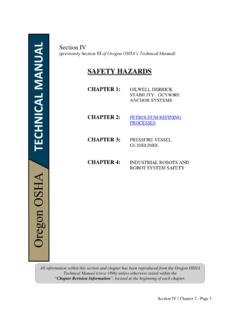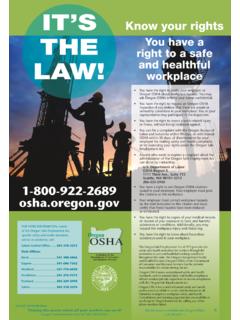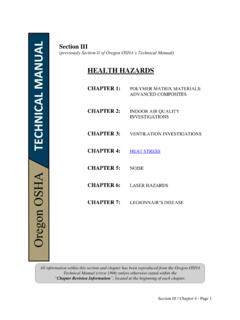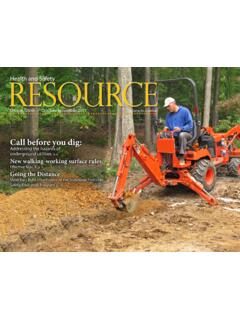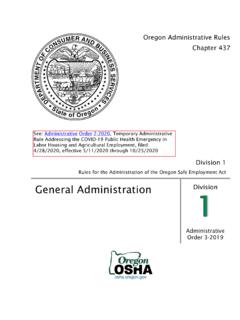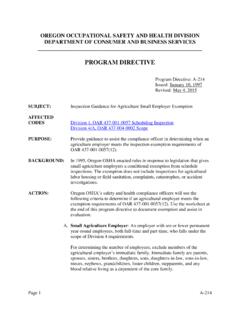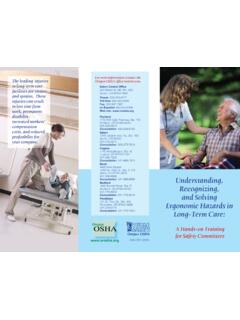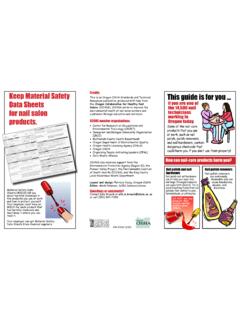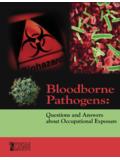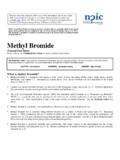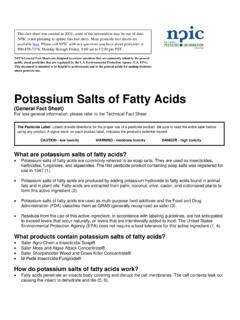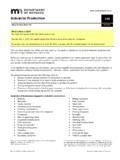Transcription of Oregon SHA FACT SHEET FACT SHEET Field …
1 Field sanitation for agricultural hand labor Division 4, Subdivision JGeneral requirementsO A R 4 3 7- 0 0 4 -1110, Field Sanitation for Agricultural Hand Labor applies only to agricultural work done in crop areas. Work covered under this standard includes weeding, cultivation, picking, sorting, and any other handwork with crops. It also applies to the operation of machinery when working along with hand labor. Another sanitation rule, 4 3 7- 0 0 4 -110 5, applies when work is done in permanent employer must provide and pay for everything required by the Field sanitation rule. All facilities provided must be clean, safe, and working waterYou must provide water that is potable meaning safe to drink. Water must be clean and free from contaminants whether you get the water from a public source, your own well, or bring it to the Field in containers. You must also provide a sanitary way to dispense the water, such as through a fountain or with a spigot into single-use cups. Employees may not use dippers or dip their cups into a common container.
2 Refill and sanitize common water containers as needed. Clearly label any non-potable water sources in work areas that are unsafe for drinking, washing, or for use with i l e t sToilets, including chemical, flush, biological, combustion, or sanitary privies, can be fixed or portable. Construction and location of onsite fixed or portable toilets must comply with the rules of the Department of Environmental Quality Onsite Wastewater Systems and Construction Standards. All toilet structures must have doors that latch from the inside, adequate ventilation and screens; and be maintained in a safe, sanitary condition. Where there are no separate urinals, toilet seats must be hinged and have the ability to be raised and lowered. You must provide at least one toilet for every 20 workers or portion of 20. Where possible, provide separate toilets for men and women and label them using a language or symbols easily understood by the workers. Toilets must be within a five-minute or one-quarter mile unobstructed walk for all workers.
3 There must always be enough toilet paper. Each toilet seat must have a toilet paper holder or facilitiesA hand-washing facility must include an adequate supply of potable water, soap, and single-use towels. You may not substitute chemical hand cleaners for the soap and water. There must be one hand-washing facility for every 20 workers or portion of 20. Hand-washing facilities must be next to the toilet facilities. You must provide a covered garbage container for used paper towels. Oregon OSHAS alem Central Office350 Winter St. NESalem, OR 97301-3882 Phone: 503-378-3272 Toll-free: 80 0 -922-2689 Fax: 503 - 9 47-74 61 WORKER HEALTH AND SAFETYFACT SHEETF ield sanitation noticeYou must post Oregon OSHA s Field sanitation notice for workers who do hand labor on crops intended for human consumption. A good location to post the notice is at each toilet and hand-washing facility or where the Field workers congregate. You can order our Field sanitation notice on weather resistant paper in English and in 's responsibilityYou must notify every employee of the location of the sanitation facilities required by O A R 4 3 7- 0 0 4 -1110 and allow employees to use the sanitation facilities as needed.
4 You must train all Field workers on good hygiene practices to minimize exposure to the hazards in the Field including heat illness, communicable diseases, and exposure to pesticide residues. Include at least the following instruction in your training: Drink water frequently, especially on hot days. Use the facilities provided as frequently as necessary. Wash hands both before and after using the toilet. Wash hands before eating and your Field workers come in contact with pesticide-treated plants or soil, the additional requirements for training and decontamination in Division 4/W, Worker Protection Standard may fact SHEET provides general guidance about the major points of the Field sanitation rule for agricultural hand labor. More information is available on Oregon OSHA s Sanitation topic page, including: Interpretation on waterless hand sanitizer use versus washing hands Rule: 4/J, Work Environment Posters: Field sanitation in English and Spanish Publication: Safe practices when working around hazardous agricultural chemicalsAttention Workers!
5 Field employer must provide:Safe drinking water Immediately available and enough for everyone. Cool and kept in sanitary containers. Dispensed from a water fountain or into personal containers ordisposable and handwashing facilities Your employer must allow you to use the toilet when you need it. Facilities must be located together and within a five-minute walk. A toilet must be: Clean, private, and have toilet paper. Provided for every 20 workers. Handwashing facilitiesmust include: Clean water and soap. Single-use towels anda trash : You must provide and maintain basic sanitation facilities and supplies for agricultural workers who prepare, prune, plant, harvest, pack, or do other types of hand labor with crops in the Field . You must display this notice if those crops are for human consumption. For more information, see OAR have the right to file a complaint with Oregon OSHA if you do not have these things. English: 800-922-2689 Spanish: 800-843-8086 InformationYour employer must tell you: The location of the drinking water, toilet, and handwashing.
6 About the importance of: Handwashing before and after using the toilet. Avoiding heat stress and infectious diseases. Reducing exposure to pesticide 4 0 -189 0 (2 /19/COM)TRASHWATERSOAPSOAPTRASH Atenci n Trabajadores! Sanidad en el empleador debe proveer:Agua potable Disponible inmediatamente y en cantidad suficiente para todos. Fresca y en recipientes limpios. Suministrada por medio de una fuente de agua o recipientes personales o en vasos desechables. Ba os y lavabos Su patr n debe permitirle usar el ba o cuando usted lo necesita. Los ba os y lavabos deben estar adyacentes y localizados a menos de cinco minutos caminando. El ba o debe estar: Limpio, dar privacidad, y tener papel de ba o. Uno por cada 20 trabajadores. Los lavabos deben tener: Agua limpia y jab n. Toallas de papel desechables y un : Usted debe proveer instalaciones y art culos de sanidad b sicos a trabajadores agr colas que preparan, podan, plantan, cosechan, empacan, o hacen otros tipos de trabajo manual con cultivos en el campo.
7 Usted debe exhibir este anuncio si los cultivos son para alimentaci n de personas. Para mayores informes, vea OAR tiene el derecho de presentar una queja con Oregon OSHA si usted no tiene estas cosas. Ingl s: 800-922-2689 Espa ol: 800-843-8086 Informaci nSu patr n debe informarle sobre: El lugar donde est el agua para beber, el ba o y los lavabos. La importancia de: Lavarse las manos antes y despu s de usar el ba o. Evitar el estr s por calor y enfermedades infecciosas. Reducir la exposici n a los residuos de pesticidas. 4 4 0 -189 0 -S (2 /19/COM)BASURAAGUAJAB NBASURASOAPThe Technical Section of Oregon OSHA produced this fact SHEET to highlight health and safety programs and rules. The information is intended to supplement the rules and provide best practices to SANITATION FOR AGRICULTURAL HAND LABOR A Division of the Department of Consumer and Business (9/19) FS-15

